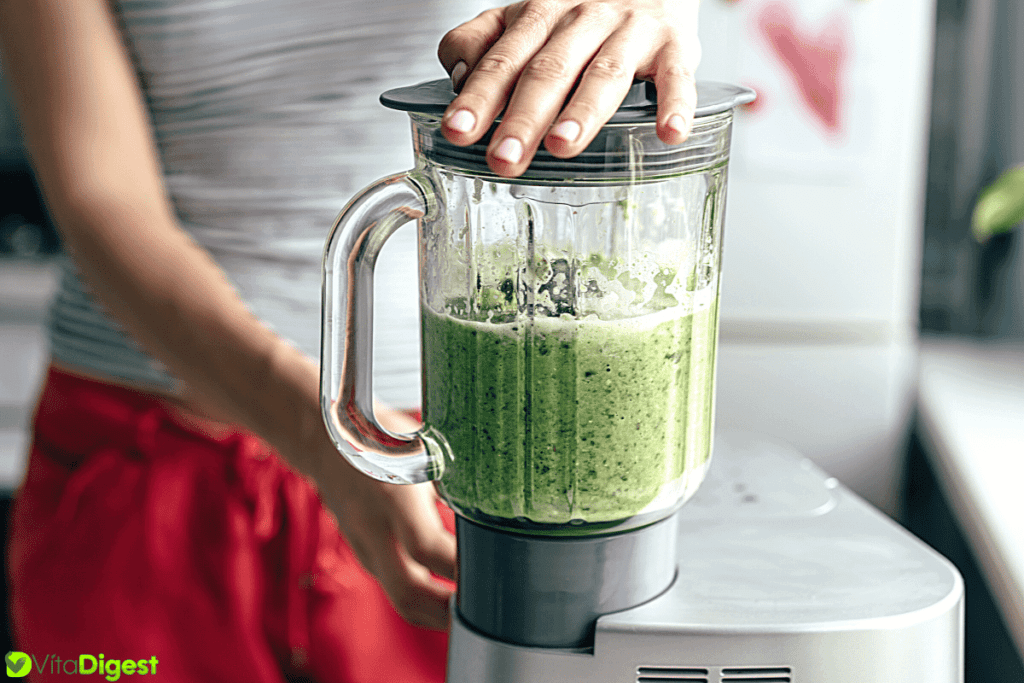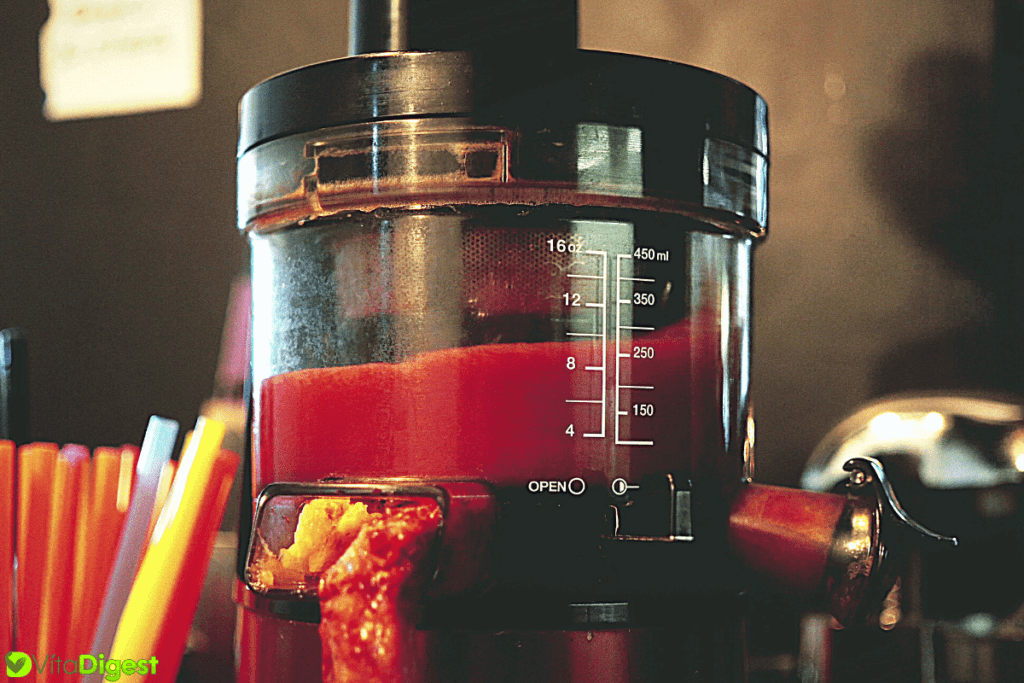When deciding between a juicer vs blender for making smoothies or juices, it’s important to understand their fundamental differences and how they affect the beverage’s outcome. A juicer separates the juice from the pulp, resulting in a smooth, pulp-free drink, whereas a blender mixes everything, producing a thicker, fiber-rich beverage. The choice between a juicer vs blender ultimately hinges on individual needs and preferences, considering the nutritional and textural differences each appliance offers. Understanding the pros and cons of each can guide you to make the best decision for your health goals and taste desires.
Benefits of Juicers
Juicers are practically a nutrient goldmine, a speed demon, and a kitchen-friendly appliance all wrapped into one. Other benefits include easy cleanup and the possibility of creative juicing recipes.
Extract More Nutrients
One of the hallmarks of juicers is their ability to extract more nutrients from fruits and vegetables. Since they’re designed to separate juice from pulp, they can squeeze out every drop of nutrient-packed juice, and leave behind the indigestible fiber. This is especially beneficial for those who prefer a more potent nutrient intake without consuming the whole fruit or vegetables.
One key highlight is that juicers are better at preserving heat-sensitive nutrients such as Vitamin C and enzymes. Why? Simply because the juicing process generates less heat and air exposure compared to blenders. The lower the heat, the higher the retention of these fragile nutrients.
Produce Concentrated Juice
The second major plus point for juicers is their ability to produce concentrated juice. This doesn’t merely reflect the rich, bold flavor you get with every gulp. It also corresponds directly to the nutritional value of the juice.
In essence, this concentration means you’re enjoying a heavy dose of vitamins, enzymes, and minerals in every serving. You’ve got all the nutrients from the whole produce compacted into your drink. It’s unlike a typical blended smoothie where the nutrients are interspersed within the fibrous pulp, reducing the concentration of nutrients per gulp.
Faster Juicing Process
Finally, one of the undeniable advantages of juicers is their efficiency. They offer a faster juicing process compared to their blender counterparts. Imagine having to rush out the door and only have a few minutes to whip up a healthy drink. A juicer wins in speed every time.
As much as the thoroughness of the blending process contributes to a fiber-rich nutrient punch, it simply can’t compete with the quick, no-fuss utility of a juicer. There’s also the cleanup to consider, thanks to their design. Plus, once you’re done juicing, there’s less messy pulp to deal with. It’s a win-win situation for those with a tight schedule or a knack for speedy kitchen chores.
Benefits of Blenders

When we think of a kitchen gadget that has the ultimate versatility to create nutrient-packed dishes or drinks, the blender is what often rings a bell. We can’t disregard the fact that the blender is a versatile appliance. In stark contrast to juicers, blenders have their unique benefits, seriously making them worthy of consideration.
Retain fiber content
Blenders are fantastic at keeping the fiber content intact. Nutritionists emphasize the importance of fiber in our diet, indicating the role it plays in maintaining a good digestive system, controlling blood sugar levels, and preventing heart disease.
A point of importance that we can’t ignore is that with blenders, we don’t separate the juice and the pulp. Instead, blenders retain the fiber content, providing a rich texture and, more importantly, keeping us fuller for a longer time.
Blenders’ fiber content retention capacity allows us to really “eat” our fruits and vegetables, even when we’re gulping them down as smoothies. It’s an easy and pleasing way to meet our daily fiber intake requirements.
Versatility in recipes
With blenders, we enter a world of culinary versatility that goes beyond simple juice. From purees, soups, nut butter to dips, cocktail drinks, and even dough for bread and cakes – there’s no limit to what a blender can accomplish in a kitchen. This versatility is a huge plus point, enabling us to wholeheartedly experiment with our creativity.
The versatility of a blender allows us to incorporate more ingredients into our diets than we ever could with juicers. Important to highlight that blenders are standard equipment in any kitchen because of their wide range of applications!
Convenient for making smoothies
The blender’s ability to make smoothies is notable because these drinks are nutritious, full of fiber, and incredibly delicious. Our mornings become more pleasurable when we start our day with a wholesome smoothie, and blenders couldn’t possibly make it any easier.
It’s a spectacular way to enjoy all the benefits of whole fruits and vegetables in a single glass. The ease and convenience of making smoothies with a blender is an aspect we appreciate more each day. Vibrant, crunchy, and healthy, smoothies made with a blender give us the real essence of raw food consumption.
Factors To Consider

When deciding between a juicer and a blender, several key factors come into play. It’s not simply a matter of choosing one over the other – it’s about aligning your selection with your nutritional needs, lifestyle, and budget.
Nutritional Needs
The core value of both juicers and blenders lies in their ability to enhance our nutrient intake. Juicers excel at maximizing vitamins and minerals. They extract highly concentrated nutrients from fruits and vegetables, leaving the fiber out.
This might be beneficial if you aim for a quick nutrient boost. On the other hand, blenders retain fiber content, which is necessary for optimal digestion and makes you feel full. If your nutritional goal is higher fiber intake, a blender would be an ideal choice.
Lifestyle and Preferences
Your daily routine and personal preferences play a significant role in this selection process. If you’re always on the go, a juicer could save you time with its smooth, easy-to-consume output.
From an ease-of-use perspective, however, blenders typically require less pre-cutting and post-use cleaning. If variety in your diet excites you, the versatility of a blender could make it the winner. It allows for a wider range of ingredients and fares well in creating sauces, soups, and smoothies.
Budget and Space Constraints
The third consideration is financial and spatial. Quality juicers tend to be pricier than blenders. It’s vital to assess whether the potential nutrient concentration is worth the extra cost. Besides, juicers usually consume more counter space and depending on your kitchen layout, this could be a decisive factor.
In taking all these points into account, making the right choice becomes a matter of matching the factors to your lifestyle. After all, blending and juicing are not mutually exclusive – they can be complementary in achieving a balanced diet and healthier living.
Juicer Recommendations
There are various types of juicers available, each suited to different needs and preferences. We’ll explore centrifugal juicers, masticating juicers, and citrus juicers in more detail below.
Centrifugal Juicers
Centrifugal juicers are real powerhouses. They’re extremely efficient, utilizing high-speed spinning blades to tear apart fruits and vegetables, extracting juice in the process. This method, while speedy and convenient, may cause some loss of nutrients due to heat and oxidation. However, if you’re often against the clock, a centrifugal juicer can be a game-changer reducing prep and juicing time by significant margins.
Masticating Juicers
Also known as “slow juicers” or “cold press juicers”, masticating juicers work by crushing and grinding produce to extract the juice – a much slower process where speed is traded off for nutrient preservation. It’s a fantastic choice if you’re keen on getting the maximum possible nutrients from your favorite fruits, veggies, and leafy greens. By minimizing heat and oxidation, these juicers ensure that the health-boosting enzymes and vitamins remain intact.
Citrus Juicers
A citrus juicer, as the name suggests, is specially designed for extracting juice from citrus fruits. If your typical round of juice involves oranges, lemons, limes, or grapefruits, this could be your ideal pick. Simple, straightforward, and fuss-free, these juicers are highly user-friendly. Moreover, they tend to be more compact, perfect for those with confined kitchen spaces.
Blender recommendations
Below we will outline the different types of blenders and detail the best options available looking at features such as speed, convenience, and efficiency.
High-Speed Blenders
High-speed blenders are a marvel in the blender world. They’re efficient, fast, and can blend almost anything, making them a great choice for those who like their smoothies silky and soups perfectly pureed. Think about it: with a powerful motor that can go up to 37,000 RPM, these blenders can pulverize even the toughest ingredients. This feature helps to unlock the most nutrients and vitamins from your food. However, quality comes at a price, so be prepared for a slightly higher investment.
Here are some high-speed blenders that have proven to perform well in various kitchen tests:
- Vitamix 5200 – Known for its reliability and durability.
- Blendtec Total Classic Original Blender – Offers innovative design and blending power.
- Ninja Professional Blender BL610 – An affordable option with impressive performance.
Personal Blenders
The ideal choice for single servings or small batch blending, personal blenders offer a perfect balance between power and convenience. They’re usually compact, portable, and easy to use – just the right features for anyone on the go. Notably, they use BPA-free cups that can conveniently double up as travel mugs. Personal blenders are also easier to clean, which is a plus for people with a busy lifestyle.
Here are a few personal blenders worth considering:
- Nutri Ninja Pro – Compact but powerful, it makes smoothie-making a breeze.
- NutriBullet NBR-1201 – An excellent option known for its nutrient extraction power.
- Oster My Blend – Marketed as a sports bottle blender, it’s practical and user-friendly.
Immersion Blenders
Unlike the previous two types, immersion blenders – also known as hand or stick blenders – are designed to be used right in the cooking container. This means you can blend in your pot, pan, or even in a bowl. It’s particularly suitable for hot foods and liquids, making it a favorite tool for making soups or sauces. Despite their compact size, they’re not lacking in power, with many models boasting up to 300 watts.
Here are some notable immersion blenders:
- Braun MultiQuick 9 – One of the most versatile immersion blenders.
- KitchenAid 3-Speed Hand Blender – Offers a comfortable grip and decent power.
- Breville BSB510XL – Has an innovative design that reduces suction for controlled blending.
So, whether you’re a hardcore health enthusiast or a practical home cook, it’s essential to choose the right blender for your needs.


1 thought on “Juicer vs Blender: Which Suits Your Needs”
Comments are closed.